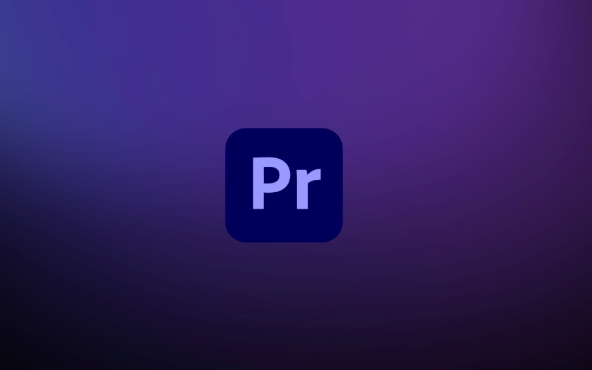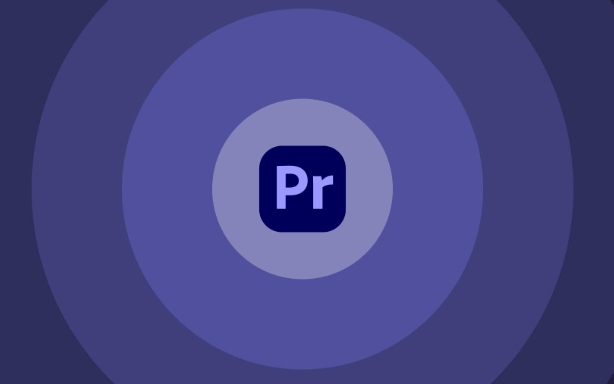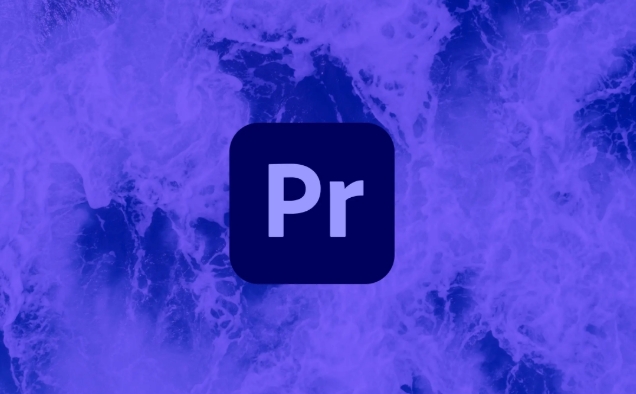To export videos that are suitable for YouTube, the key is to select the correct parameters. First, the video size and frame rate should match the content. It is recommended to 1920×1080 (FHD) or 3840×2160 (4K UHD). The frame rate is 24fps, 25fps, 30fps or 60fps according to the purpose. Secondly, it is recommended to use H.264 for the encoding format, and the preset can be selected as "match source aspect ratio" or "YouTube 1080p HD". The code rate is VBR twice, 1080p is set to 15~20Mbps, and 4K is set to 35~50Mbps; thirdly, the audio is encoded with AAC, the sampling rate is 48kHz, and the two channels are enough; finally, the file name should be standardized before exporting, such as video_final_v2.mp4 Or S01E03_introduction.mp4, and prepare a clear cover image for easy subsequent management.

Exporting videos to YouTube and using Premiere Pro is actually quite straightforward. The key is to choose the right parameters to ensure that the clarity and loading speed are online. Many people click "Export Media" as soon as they come up, but the image quality is blurred or loaded slowly on YouTube. In fact, as long as you pay attention to a few set points, you will basically not get stuck.

Video size and frame rate should match your content
YouTube supports a variety of resolutions, but you have to decide based on the items you edit. If you shoot at 1080p, don't lower it to 720p; if it's 4K editing, it's best to export 4K, so that YouTube can provide higher-definition playback options after uploading.

Common recommendations:
- Resolution: 1920×1080 (FHD) or 3840×2160 (4K UHD)
- Frame rate: 24fps (movie sense), 25fps (European TV), 30fps (general), 60fps (more action, game category)
If you are not sure about the final effect, you can first export a small test video to upload it.

It is recommended to select "H.264" for encoding format and presets.
There are many encoding options when exporting Premiere Pro, but the most compatible YouTube is H.264. This format ensures image quality and also has good compression rate. The files will not be too large and uploads will not be stuck for too long.
Export steps:
- Media Export → Use the highest rendering quality
- Select H.264 format
- Select "Match source aspect ratio" or "YouTube 1080p HD" in the preset to save trouble
- In terms of bit rate, it is recommended to use "VBR twice", and the target bit rate is set to 15~20Mbps (1080p). For 4K, it can be mentioned 35~50Mbps.
In terms of audio, AAC encoding is generally used, with a sampling rate of 48kHz and two channels, unless you have special needs.
Don't ignore file naming and cover title
Although this is not the content in the export settings, many people only find that the title is messy after uploading it, or the cover image is not prepared in advance. It is recommended that you plan before exporting:
- Write the file name clearly, such as
video_final_v2.mp4 - If it is a series of content, plus the number, it is better to manage, such as
S01E03_introduction.mp4 - The cover image can be used to capture a clear picture with the screenshot tool, and then add some text instructions with PS or Canva.
These details look small, but they are much more convenient to organize after uploading to YouTube, especially for channels, and unified naming specifications are very important.
Basically that's it. The export settings are not complicated, but they are easy to ignore details, especially the bit rate and frame rate. Try a few more times and you will know what is suitable for you.
The above is the detailed content of how to export from Premiere Pro for YouTube. For more information, please follow other related articles on the PHP Chinese website!

Hot AI Tools

Undress AI Tool
Undress images for free

Undresser.AI Undress
AI-powered app for creating realistic nude photos

AI Clothes Remover
Online AI tool for removing clothes from photos.

Clothoff.io
AI clothes remover

Video Face Swap
Swap faces in any video effortlessly with our completely free AI face swap tool!

Hot Article

Hot Tools

Notepad++7.3.1
Easy-to-use and free code editor

SublimeText3 Chinese version
Chinese version, very easy to use

Zend Studio 13.0.1
Powerful PHP integrated development environment

Dreamweaver CS6
Visual web development tools

SublimeText3 Mac version
God-level code editing software (SublimeText3)
 how to fix red frames in Premiere Pro
Jul 07, 2025 am 12:16 AM
how to fix red frames in Premiere Pro
Jul 07, 2025 am 12:16 AM
The red box appears in PremierePro because the preview file is not generated or the material path is incorrect. Common reasons include just imported projects, material path changes, insufficient cache space, or failed proxy files loading. Solution: 1. Wait for automatic cache generation; 2. Manually generate preview rendering timeline; 3. Check and relink missing materials; 4. Clean and rebuild media cache. When using proxy clips, you should confirm that the proxy files are correctly associated and appropriately reduce the playback resolution to improve preview fluency.
 how to make text appear one letter at a time in Premiere Pro
Jul 08, 2025 am 12:02 AM
how to make text appear one letter at a time in Premiere Pro
Jul 08, 2025 am 12:02 AM
To display text letter by letter, use PremierePro’s built-in “Typewriter” animation preset or manually adjust the opacity or zoom of each character. 1. Use presets such as "Typewriter-Reveal" in the "EssentialGraphics" panel to directly apply the verbatim effect; 2. Enable character-by-character animation through the "EssentialGraphics panel" and select Opacity or Scale for customization; 3. Set Start and EndOffset to control the animation rhythm and combine keyframes to achieve dynamic changes; 4. You can adjust the offset, add blur or color change to enhance the effect. It is recommended that each letter lasts 0.1-0.2 seconds and is suitable for phrases rather than long paragraphs.
 how to rotate video in Premiere Pro
Jul 04, 2025 am 01:33 AM
how to rotate video in Premiere Pro
Jul 04, 2025 am 01:33 AM
There are three ways to rotate videos in PremierePro. 1. Use the "Motion" option in the "Effect Control" to accurately adjust the rotation angle, which is suitable for fine operation; 2. Use the "Create Sequence from Clip" function to automatically correct the vertical video direction of the mobile phone, saving time and effort; 3. Use "Crop" and "Zoom" to adjust the screen to fill the screen and avoid black edges to ensure complete output quality.
 how to fade audio in Premiere Pro
Jul 05, 2025 am 12:50 AM
how to fade audio in Premiere Pro
Jul 05, 2025 am 12:50 AM
Adding a fade effect to audio in PremierePro can be achieved in three ways: 1. Use audio transition effects such as "Constant Gain" or "Exponential Fade" and drag directly to the beginning of the audio clip; 2. Manually add volume keyframes in the "Effect Controls" panel, and control fade speed and nature by adjusting the keyframe position and curve; 3. Use the "Trail Mixer" to drag the volume slider in real time to record the operation track, which is suitable for unified management of multi-track audio. Each method has its own advantages. Newbie can choose to quickly achieve the transition effect, advanced users are suitable for manual adjustment or use the track mixer to obtain more refined control. Finally, it is recommended that preview ensures that the audio transition is natural and smooth.
 how to apply an effect to multiple clips in Premiere Pro
Jul 05, 2025 am 12:22 AM
how to apply an effect to multiple clips in Premiere Pro
Jul 05, 2025 am 12:22 AM
There are three ways to quickly add the same effect to multiple clips in PremierePro: 1. Use the "EffectChainer" tool to first apply the effect to one clip, and then click other clips one by one through the chain icon in the effect panel to apply it in batches; 2. By copying and pasting attributes, right-click the first clip with added effects in the timeline to select copy, then select other clips to right-click to select paste attributes, and only select video or audio effects to paste; 3. Use the adjustment layer to process the video effect, create a new adjustment layer and place it above the target clip, and drag the effect to the adjustment layer to affect all clips below it. The above methods can significantly improve work efficiency and are suitable for the needs of different scenarios.
 how to normalize audio in Premiere Pro
Jul 04, 2025 am 12:16 AM
how to normalize audio in Premiere Pro
Jul 04, 2025 am 12:16 AM
NormalizingaudioinPremiereProadjuststheloudestpeakinacliptoatargetlevel,balancingvolumeacrossclips.1.Right-clickaclipandchoose“AudioGain…”2.Select“NormalizeMaxPeakto”andsetatargetlike-1dBor-3dB.3.ClickOKtoapply;thisscaleseachclip’svolumeuniformly.Itw
 how to create a cinematic look in Premiere Pro
Jul 06, 2025 am 12:07 AM
how to create a cinematic look in Premiere Pro
Jul 06, 2025 am 12:07 AM
To bring up a movie-like picture in PremierePro, the key is to adjust the basics and follow the following steps: 1. Use the LumetriColor panel for basic corrections and creative color grading to avoid directly applying presets; 2. Add FilmGrain effect to improve texture but not excessively; 3. Control the details of highlights and shadows, and combine local adjustments to enhance levels; 4. Set appropriate output parameters such as H.264 or ProRes, 10bit color depth to preserve the color grading effect.
 how to make a video look like old film in Premiere Pro
Jul 11, 2025 am 12:04 AM
how to make a video look like old film in Premiere Pro
Jul 11, 2025 am 12:04 AM
If you want the video to present the old movie effect in PremierePro, the core is to adjust color, add noise, simulate film scratches and adjust the frame rate appropriately. 1. Adjust the color style: Use the LumetriColor panel to reduce saturation, increase warm tones, or apply "antique" presets and fine-tune according to the picture; 2. Add particles and scratches: Add appropriate amount of particles through plug-ins or built-in effects, superimpose transparent scratch layers and select the appropriate blending mode; 3. Adjust frame rate and playback speed: Export high frame rate materials to lower frame rates or use frame fusion to simulate the playback rhythm of old movies; 4. Add black edges and slight jitter: Use a mask layer to add black edges, and retain slight shaking through WarpStabilizerVFX to enhance the sense of reality. Each step requires






